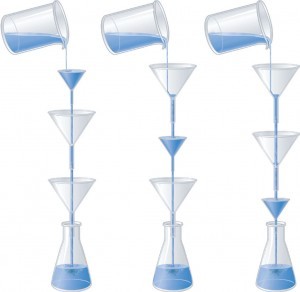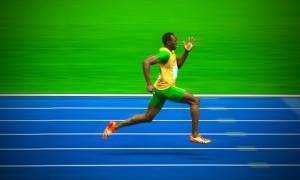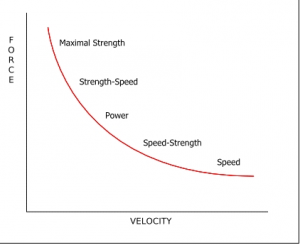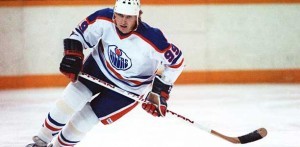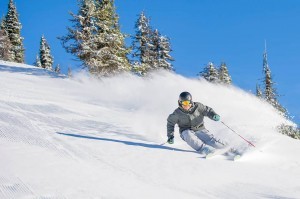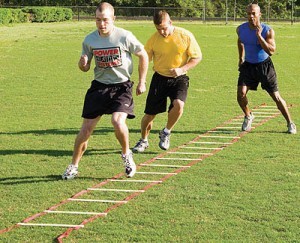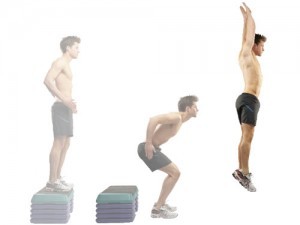Growing up we played sports to develop our fitness and athleticism. We weren't aware of LTAD, the risks of early specialization and the benefits of being a multi-sport athlete. We played football at school, swam competitively, rode our bikes in the summer and skied in the winter. And for the most part this worked pretty well based on the fact we pl...
The Importance of Lower-Limb Joints on Sprinting
- Chris Collins
- Fitness
- 1618 Hits
- 0 Comments
-
Did you ever take chemistry in school? If so, you may remember something known as the rate limiting step. What this means is that when there's a chemical reaction the speed of the reaction may be limited by a particular element. Increasing the concentration of this element allows the entire reaction to happen more quickly. [caption id="attachment_5569" align="aligncenter" width="300"] With the 3 pours, the first funnel will be limited, followed by the middle series and then the 3rd series of funnel. The flow rate in each is limited by the smallest funnel. It's important to know the rate limiting or determining step because then we know where our efforts will generate a better result. Let's look a different example to see how this works. Imagine a busy restaurant that measures each day's success by the number of tables turned over. There will be a maitre-d, a hostess, a server, sous-chefs, head-chefs, bussers and dishwashers. If the dishwasher doesn't show up for work eventually the plates pile up and there will no clean plates to set a new table. Everything backs up at this point. And it doesn't matter if everyone else does a little bit more because the dishes are still piling up, not getting washed and tables are not getting turned over. We can know appreciate that when we're looking to achieve a goal there may be something that limits the outcome. With sprinting for example, we know there are contributions from the lower body joints i.e. the ankle, knee and hip. When walking there is a contribution from each of these joints. As we progress from walking to sprinting is the increased role of these joints proportional? Or are certain joints prioritized? A recent study looked to answer this question. Researchers looked at the involvement of the ankle, knee...
How Hills Can Make You Faster
- Chris Collins
- Fitness
- 1733 Hits
- 0 Comments
-
Do you watch Fargo? I'm not talking about the movie, which was pretty good, but instead I'm referring to the TV show. We're just getting into it and it's awesome. But a word of warning to those with small children or that are squeamish...there's some killing and bloodshed. In fact the only thing that probably kills more than Billy Bob Thornton's character is speed. [caption id="attachment_5317" align="aligncenter" width="206"] Only speed kills more than Billy Bob Thornton's character on Fargo. That's the truth. In sports, speed kills. And for team sport athletes there are a number of things we can do to improve our speed. One thing I really like to incorporate into training to help with speed is to run some hills. Why Run Hills? Hills can be a great tool to help us get faster because it encourages proper foot contact. Imagine bounding up a fill as though jumping from one foot to the next. This doesn't really work we if land on the heel and try roll through the foot. If we used a heel-toe roll strategy we would lose all the momentum generated by bounding from one leg to the next. And we would slow right down. https://youtu.be/p2bYUE2roX4 The other great thing about running hills is the increased need for the arm action. The arms will help with propulsion and balance. Sometimes we'll see athletes start to move but not using their arms initially. In this case they are not as fast or explosive as they could be. Due to the inclination of the hill the arms become more of a necessity to assist with propulsion and to help us maintain balance as we jump from foot to foot. This can become more apparent when running downhill. Larger arm swings from the shoulder will help keep the arms...
The Best Cues for Coaching Speed
- Chris Collins
- Fitness
- 1747 Hits
- 2 Comments
-
This year Immaculata High School added a Sports Academy program for volleyball, soccer and basketball. And Okanagan Peak Performance Inc has been helping out with the strength and conditioning for this program. This morning we spent a good portion of the training session working on speed. And there a number of cues for speed to apply to almost every sport. Below are a number of things that were shared with the athletes to improve their speed 1. Knee Up - Toe Up One of the biggest factors that distinguish a runner from a sprinter is the degree of knee lift. The best sprinters in the world will flex the knee and hip to lift the frontside leg. [caption id="attachment_5282" align="aligncenter" width="300"] Knee up toe up on the front side leg. Runners on the other hand have minimal frontside knee and hip flexion. [caption id="attachment_5286" align="aligncenter" width="300"] Runners have less knee lift compared to sprinters. As for the toe up position this is what we refer to as a dorsi-flexed position. Toes pointed down is called plantar flexed. In order to take advantage of the stretch shortening cycle and elastic potential of the foot and ankle we want to be in the toe up position. 2. Longer is StrongerA longer core is a more stable core. If you trace from your tail bone to the base of your skull at the back of your head you can get an appreciation of the length of your spine. A taller posture lends to more stability than a shortened or slumped posture. The next time you watch a race pay attention to how tall the better athletes are compared to the later finishers. What I mean by tall is whether or not they get shorter with ground contact or not? If they can stay tall they...
How to Train for Speed
- Chris Collins
- Fitness
- 1741 Hits
- 0 Comments
-
What’s one thing that’s different as you move up to the next level of sport? I’m talking about a quality that changes and gets higher or better regardless of the sport in mind. It doesn’t matter if we’re talking about hockey, soccer, swimming or football, improving in this one area makes you more competitive in your sport. It gives you a better chance of winning or getting on the podium. What do you think that one thing is? Some people might guess size. And if your background is in collision sports, such as football or rugby, additional size or mass may be helpful. But that’s not what the answer. Others might guess technique or tactics. For example, if you’re a baseball player maybe learning how to throw a particular pitch really well allows you to advance and succeed in higher levels of baseball. But that’s not it either. The one thing that will always help you in higher levels of sport is speed. Think about that for a second. Are there any sports where additional speed is a detriment? Or are there any sports where speed isn’t important? I can’t think of any examples so let me know if you can. Another thing that proves this point is after working with thousands of athletes over the past twenty years I have seen many advance through amateur to semi and finally to full professional and elite. And when you ask them about the difference of finally making it pro they all say it’s the speed of the game. They didn’t learn any new moves or plays. College football players aren’t undersized compared to NFL players. It’s that all of the players can move at a minimum threshold of speed and the game itself is played at a faster pace. So when an athlete is...
How to Get Faster - Without Really Trying
- Chris Collins
- Fitness
- 1805 Hits
- 0 Comments
-
If you're a fan of sports than that usually means you're a fan of speed. Speed is usually what's featured on the 'play of the day' for the sports broadcast. And the higher the level of sport you achieve the faster the game becomes.Now of course there are exceptions to this rule. Gretzky would be one for sure. He definitely wasn't the fastest guy in the league. Or his team. Heck, he probably wasn't even the fastest on his line. But for what he lacked in speed he made up with great vision, a competitive spirit and a sense of where to be on the ice.[caption id="attachment_4995" align="aligncenter" width="300"] The Great One was not the fastest one.But back to the discussion of speed usually new coaches learn there are a couple of ways to make an athlete faster. You can:A. increase stride rate or how quickly you can turn the limbs overB. increase stride length or how much horizontal distance can be covered with each strideWhen a coach considers these two options for increasing speed they will sometimes seek out drills and exercises to improve in these two areas. To improve stride rate there is an emphasis on being able to produce force at a higher rate. Think of things like jumps, hops, bounds, med ball throws and Olympic lifts and you'll get the idea. These exercises usually involve extension at the ankle-knee-hip with an explosive effort.To improve stride length sometimes this is approached as either a strength or mobility issue. Or both. If an athlete lacks strength they wouldn't be able to propel themselves effectively from one position on the ground to another. Or maybe they have adequate strength but lack mobility at the hip preventing optimal range of motion through the gait cycle.Attacking speed improvement from either of these...
The Myth of Triple Extension
- Chris Collins
- Fitness
- 1963 Hits
- 0 Comments
-
Last weekend Graeme and I had the opportunity to attend a speed coaching clinic with Derek Evely. Derek was the Leeborough Centre Director of UK Athletics from 2009-2012 prior to the London Olympic games in 2012. He has coached a number of number of Olympic podium athletes and continues to work with some of the best hammer throwers in the world. Derek was a wealth of knowledge and a great presenter. His delivery of the content was professional and allowed for discussion and questions. At one point he even Skyped in 3 of the best sprint and hurdles coaches in the world with Kevin Tyler, Andreas Behm and Stu McMillan from Altis in Arizona. If you're not in sprinting circles these names probably don't mean too much. But these four individuals represent the best of the best when it comes to sprinting knowledge and coaching ability. And it was definitely a special opportunity to listen to them and be able to ask questions. And let's face it...every athlete wants more speed. Actually I'm not even an athlete but I still want to move quickly. There's just something about being able to accelerate and hit a top end speed better than most that appeals. This might have to do with having a burst of speed a the end of a road race, of being able to win battles in team sports (i.e. basketball, football, soccer etc) or simply wanting to look more like a sprinter than a runner. [caption id="attachment_4878" align="aligncenter" width="299"] Running versus Sprinting - Which body type do you prefer? So if we can agree that all athletes want more speed and that most general fitness clients wouldn't mind moving more quickly as well than we need...
Post Activation Potentiation
- Chris Collins
- Fitness
- Training
- Fitness Education
- 1691 Hits
- 0 Comments
-
Speed is one those things every athlete wants more of. It may be described as quickness or having a faster first step but ultimately it comes to having more horsepower. But how we go about developing speed is a good question. Ask five different coaches what they do for speed training and you may get five different answers. Recently there was an article published in the Journal of Strength & Conditioning Research by Hancock et al which looked at how post activation potentiation (or PAP) affects swim performance. This research team took 30 collegiate swimmers and had them do a standard warm-up followed by a 6 minute rest. After the rest the swimmers performed a 100 m time trial with splits at the 50 m mark plus blood lactacte was sampled. One grip did 4x10 m maximal swims on the minute against the resistance of a power rack before taking the 6 minute break. These four swims lasted an average of seven seconds and the resistance for each swimmer was set based on their mass and 100 m swim time so as to equivalent for everyone. What they found was that performing the four maximal sprints resulted in a swim times that were 0.54 seconds faster than the group that didn't perform them. Think 0.54 s doesn't matter in the 100 m freestyle in swimming? It would if you were #11 and you were the only to perform this kind of warm-up. In theory it could shave 0.54 seconds off his time and take him from 48.67 to 48.13 and the gold medal.RankHeatLaneNameNationalityTimeNotes165Nathan Adrian United States48.19Q261Gideon Louw South Africa48.29Q382Sebastiaan Verschuren Netherlands48.37Q484James Magnussen Australia48.38Q585Brent Hayden Canada48.51Q667Brett Fraser Cayman Islands48.54Q678Pieter Timmers Belgium48.54Q, NR863Nikita Lobintsev Russia48.60Q987Cullen Jones United States48.61Q1077Konrad Czerniak Poland48.63Q1164César Cielo Brazil48.67Q1274James Roberts Australia48.93QI point this out to show that a half second...
Slow it down to get better
- Chris Collins
- Fitness
- Training
- Injury Prevention
- 1481 Hits
- 0 Comments
-
Last week I had a ski lesson. And it was one of the times when I had an 'aha' moment. During the lesson the instructor, Sander, had me try doing big and small radius carving turns. [caption id="attachment_4577" align="aligncenter" width="300"] Sander showing how it's done. And I noticed something that surprised me. I felt smoother and skied better with small, quick turns than I did with larger turns. This was surprising because I would have thought that adding speed to a movement makes it more technical and thus more difficult. In the case of the turns when I performed small, quick turns there was a natural stretch reflex that flowed from one turn to the next. The momentum initiated the weight transfer, the rolling of the skis, the tall and short stature as well the angulation and inclination necessary to carve the skis. (had to throw in the part about inclination for Greg) If you're not a skier, don't worry. The take home message is that skiing with speed and quicker turns creates a momentum and a flow which makes it easier, for me anyway, to get on the edges of my skis. When I went to larger turns I was staying forward in my boot through the turn. This wasn't allowing the ankle to release and thus was blocking the chain reaction of events that should follow from the release of the ankle i.e. getting taller, realigning the knees, shifting the hips, achieving good angulation and inclination. It's kind of like trying to steer your car with the brakes on (I'm not a car guy, so cut me some slack here). When the brake is pressed through the floor you don't have the same freedom to control the car by steering it. Only once you release the brake can you regain more control...
4 Tips for Speed
- Chris Collins
- Fitness
- Training
- 1579 Hits
- 1 Comment
-
If there was one quality I would always choose as a coach it would be speed. You can have big players and strong players. You can have fit players and smart players. But the truth is that speed kills. Period. So knowing the importance of speed how do we get faster? Unfortunately many still believe this is the way to develop speed. And while 'speed' ladders might be useful for working on different footwork patterns, coordination or simply to help an athlete warm-up they don't do much in terms of speed development. Below are four ways to improve your speed and dominate your game. Speed Tip #1 - Increase Your Stride RateThere is formula that gets passed around coaching circles that speed = stride rate x stride length. While there is some truth to this there is more than be done than simply working on these two qualities. When we talk about stride rate we are referring the the turnover of the legs. How quickly can an athlete take a given number of steps when sprinting. And primarily what we are concerned with here is training the relevant muscles to fire quickly. And to do so is not so much a questions of strength or fitness as it of nervous system development. There have to be elements in the training program where the athlete is performing movements at high speed with sub-maximal loads. Speed Tip #2 - Increase Your Stride LengthHave you ever seen an athlete whose arms and legs are moving really fast? But the weird thing is they aren't moving faster than any of the other athletes in the game. Some coaches get fooled into thinking some of their athletes that move like this are really fast. But when you test them they aren't fast. And in games they...
Easy way to sprint 5% faster
It's hard to find a sport where having less speed would be an advantage. And in this case we would have to be talking about sports that are objectively measured i.e. faster,higher,stronger as opposed to subjectively measured with judging.I don't have to think back very far to a situation where I wish I was a little bit faster.This situation goes back to when Megan and I were in Las Vegas for a conference and had plans to go to a concert on one of the nights. Anyways the conference schedule was to have all the sessions completed by 6 pm with the concert set for 730 pm.It looked as though everything was going to align perfectly for us and then the presentations went over time and the conference was behind schedule. This meant that we would now miss the last presentation of the day.But guess what?The last presentation was by a friend of mine. And were sitting up near the front row.I was waiting for the previous speaker to finish up so we could sneak out during the break and not create a distraction during my friend's presentation.Of course the conference host takes the stage and announces there won't be a break and they will go straight in to the next session. So I lean over and tell Megan 'we have to leave now'.So we pack up our stuff, trying to quickly and quietly exit from the room as the next presentation is starting.Now this where more speed would have helped me.I had been sitting for 9 hours and so I would be tight and slow moving. If I had the time what would be the best way to to sprint the 20 or so meters to the back of the room and out?Should I do some aerobic exercise?What about a...
Are 800s the Ultimate Fitness Test?
- Chris Collins
- Fitness
- Training
- 1571 Hits
- 0 Comments
-
Have you ever run 800s? If you've competed in track and field there's a good chance you may have some experience with this distance. And therefore you know how awful this event can be. Why is it so awful? Well it's too long of a distance to sprint and not long of a distance to really pace yourself. It's basically 2 to 3 minutes of pure physical discomfort. And if you're into that sort of thing than you've found the perfect workout to inflict as much pain and discomfort as you can handle. But there are a few other reasons I like the 800s as a training distance as it provides valuable feedback as to what you should workout on to improve performance. Below are 4 Benefits of Running 800s. Benefit #1 - Measure of Overall SpeedThe nice thing about 800s is that you do two laps of a track oval to achieve this distance. And based on your time you get a bit of an idea of your overall speed. If you want to know how you compare to the world record you can do two laps and see how close to 1 minute 40 seconds which is the current world record. Are you within 30 seconds of the world record? 60 seconds? More? Test yourself and see how your overall speed ranks. Benefit #2 - Measure of Your PaceAs I mentioned at the beginning you can't sprint an 800 m nor can you pace yourself. And after running this distance a few times you'll quickly learn a bit about your pace. For example, let's say your total time was three minutes which is not too shabby. And your splits were 1 min 40 for the first lap and 1 min 20 for the second. Since most people tire in...

